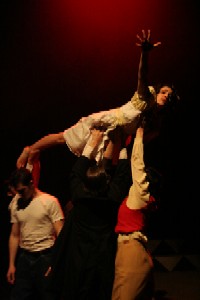| We Can't Reach You, Hartford |
 An investigative history of the Hartford Circus Fire of July 6th, 1944. Nominated for a Fringe First at the 2006 Edinburgh Fringe Festival. An investigative history of the Hartford Circus Fire of July 6th, 1944. Nominated for a Fringe First at the 2006 Edinburgh Fringe Festival. |
| Daguerreotype |
| In the twilight of his life, famed photographer Matthew Brady must choose between the life he has built and the legacy he wants to leave behind. |
| Tone Clusters |
| Renowned prose author Joyce Carol Oates explores honesty, perspective, and denial through one couple's harrowing attempt to save the person they love |
|
| Tuesday, June 19, 2007 |
| How best to reach? |
Having just had a very fruitful discussion with resident set designer Nick, I would like to put forth my thoughts on documentary theater. I have been leery of this as a blog entry, as I was unable to make much of a heads or tails of it in a 60 page thesis. However, I have accrued some repeated questions and thoughts and themes that I'd like to share.
1. How important is factual accuracy? First of all, what is factual accuracy? History books have errors, our entire process is built around the fact that history is unreachable. All we have to offer is perspective, what sticks to our artistic team when a whole lot of research is thrown at us. I described it to Nick as a tug-of-war. On one side is the artistic product and on the other side is What We Know, even if what we know isn't true. Perhaps its literature, philosophy, an idea. The goal is for the rope to remain taut. These things pull against each other ceaselessly and if we successfully strive for truth and for excellence, perhaps the center will wobble, but not collapse.
2. What are we trying to create? For this, I go to Richard Schechner, who describes the Wooster Group's "Rumstick Road." Schechner describes the "subjunctive" mood that is created when modern avant garde techniques are paired with actual footage from Spalding Gray's family's past. In examining the definition of subjunctive, one sees the "hypothetical" mood, a mood that exists not in the past and not in the present, but in some combination of the two reaching towards each other.
3. How best to reach? My favorite systems of dealing with history and historical subject matter right now are that of Suzan-Lori Parks and Charles Mee. Both have manifestos so bulletproof that they are repeated and repeated and seem to rarely change. The American Story Project is still working towards this magical system that may or may not exist and that reconciles the frustrations of dealing with factual material. We use our literary sensibilities, we make associations, we try to imbue each production with the message that history is memory, perspective, literature, imagination, cycles (or maybe that it isn't all of these things) and that when we said "we can't reach you, hartford," we weren't really talking about any telephone operators. Most importantly, I want to investigate how the past can live again, how it can feel as present and as vital as anything. Today I saw an extraordinary panel called Liz Lerman on Art and Spirituality. In it, Lerman described being present for a Hawaiian chant in which the woman began "Invite your ancestors to come in." Lerman began by picturing her immediate and extended family. Again, the woman repeated "Invite your ancestors to come in" (I'm paraphrasing, but that was more or less the gist). Lerman felt she was out of ancestors, and began thinking of her dance ancestors (Martha Graham, Isadora Duncan, etc...), but the woman kept repeating. Lerman pictured Thomas Jefferson, the founding fathers. Finally, the woman finished her chant: "You are not alone. You never were." This story floored me, and this is what I believe that our investigation of history can achieve. The cyclical, the ghosts of our past, the forces that drive us into the future.
I'd like to end by asking of our readers how, as artists, do you reconcile history with performance and the issues this tension creates? |
posted by Jess @ 10:07 PM  |
|
|
|
|
| Who We Are |
|
| Previous Posts |
|
| Archives |
|
| Our Kind of Theater |
|
| Reading Material |
|
|
